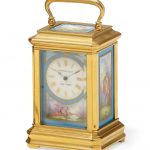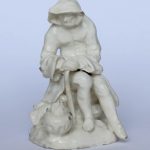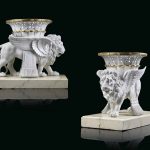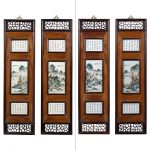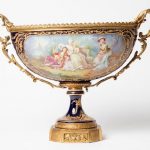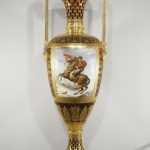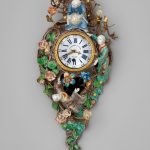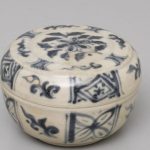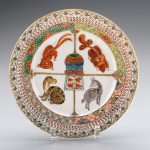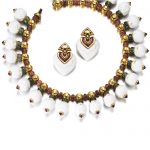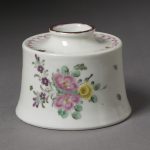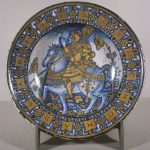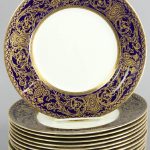Porcelain is a vitrified pottery with a white, fine-grained body that is usually translucent, as distinguished from earthenware, which is porous, opaque, and coarser. The distinction between porcelain and stoneware, the other class of vitrified pottery material, is less clear. In China, porcelain is defined as pottery that is resonant when struck. In the West, it is a material that is translucent when held to the light. Neither definition is totally satisfactory: some heavily potted porcelains are opaque, while some thinly potted stonewares are somewhat translucent. The word porcelain is derived from porcellana, used by Marco Polo to describe the pottery he saw in China. Reference: Encyclopaedia Britannica
A French gilt brass and porcelain miniature carriage timepiece retailed by Tiffany & Co., New York circa 1900 The circular enamel dial with Roman numerals inscribed TIFFANY & Co NEW YORK, the painted panels with figures in landscapes, the single train movement with lever platform escapement. height 3 3/4in (9.5cm)
Sold for US$ 1,625 (£ 1,248) inc. premium at Bonhams in 2018
Porcelain figure depicting Winter. Made by the Bow Porcelain Factory circa 1750
Reference: © The Trustees of the British Museum
TWO SEVRES WHITE BISCUIT PORCELAIN MODELS OF LIONS SUPPORTING BASKETS (LIONS ‘CORBEILLES’ OR ‘CANEPHORES’ ) THE BISCUIT PORCELAIN CIRCA 1843-45, ONE LION INCISED ‘MAS/AVRIL 43’ THE OTHER ‘MAS/OCTOBRE 45 / OCBRE.45’, INCISED MARKS TO BOTH BASKETS, ONE WITH GREEN STENCILLED LP MONOGRAM MARK FOR 1846 Each winged lion caparisoned with a tasselled saddlecloth moulded with anthemia, supporting pierced and gilt baskets, each on a painted wood faux marble rectangular base 14. 1/4 in. (36.4 cm.) high
Sold for GBP 50,000 at Christies in 2018
Set of Four Chinese Panels Inset with Porcelain Plaques Height of each panel 43 1/2 inches, width 12 inches each appears to be in generally good condition; each of the porcelain panels appear to be in generally good condition with no apparent breaks or cracks; there are cracks and breaks to some of the fretwork wood elements at the top and bottom sections of the panels; some of the wood seam joins are now beginning to separate; there are some cracks and splitting to the wood veneers; not examined from behind
Sold for $2,500 (includes buyer’s premium) at Doyle New York in 2018
A SEVRES STYLE FRENCH ORMOLU CENTERPIECE
Cobalt blue ground porcelain with ormolu bronze mounts, gilt embossed foliate trails, gilt painted details. Two painted scenes, one with two women and a man playing a lute, signed ‘Cottinet’ in the lower right corner. Reverse features an unsigned painted scene of a country view with abandoned flowers and hat near the foot of an architectural ediface. Oval jardiniere mounted on a similar cobalt blue pedestal base, with gold painted trim. Measures 17 x 23 x 11.5 inches. CONDITION Good condition, painted elements very strong, mild wear to ormolu. Missing one ornate screw nut to the underside of the ormolu framework, bolted at the base of the jardiniere and pedestal foot, both a bit loose. This piece has been used as a centerpiece with faux flowers and shows a few spots of masking tape residue on the inside bowl.
Sold for $750 at Circle Auction in 2018
On the baptism of his son, King of Rome, on 10 June 1811, Napoleon offered the infant’s godmother – his own mother, Madame Mère – this spectacular porcelain fuseau vase. The tortoiseshell ground provides a sumptuous setting for a portrait of Napoleon crossing the Alps, after David’s famous painting. The vase is typical of the designs of Alexandre Brongniart (1770-1847), director of the Sèvres Manufactory, who saw in porcelain a way of giving great history painting imperishable form.
Reference:The Louvre
Étienne LeNoir (French, 1675–1739) Wall Clock
Étienne Le Noir was the patriarch of a dynasty of French clockmakers who specialized in movements for clocks with lavishly decorated cases for royal and aristocratic patrons. This clock is unique in having its case made of porcelain rather than more typical gilded bronze, and there are only two other surviving examples of wall clocks with Chantilly porcelain cases. The figures imitate Japanese porcelain, as was quite usual at the Chantilly porcelain factory. Circa 1735–40
Reference: The Metropolitan Museum of Art
This blue and white Vietnamese porcelain covered box is one of the examples produced during fourteen century to fifteen century in Vietnam. It is likely that these trade wares were made in the north in Hai Huong province, relatively close to the trading port of Van Don, and at Go Shnh in central Vietnam.
Reference: Museum of Applied Art and Sciences
Porcelain Plate Chinese for export 20th century
Center quartered with exotic animals Rim has two bands of repeated motives inner band in four designs. In varied colors.
Reference: Museum of Fine Arts Boston
Porcelain and gem set demi parure, ‘Chandra’, Bulgari Comprising: a necklace set with green and pink tourmalines supporting a fringe of porcelain beads, length approximately 390mm; and a pair of ear clips, each piece signed Bulgari, Italian assay mark for gold and maker’s mark.
Sold for 35,000 CHF at Sothebys in 2018
Inkstand of hard-paste porcelain. Painted with flowers. Place of Origin Plymouth (made) Date 1768-1770 (made) Maker Plymouth Porcelain Factory
Reference: © Victoria and Albert Museum
